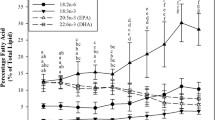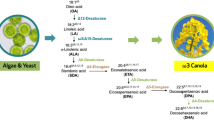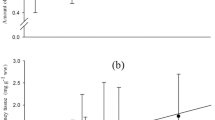Abstract
Camelina oil (CO) replaced 50 and 100 % of fish oil (FO) in diets for farmed rainbow trout (initial weight 44 ± 3 g fish−1). The oilseed is particularly unique due to its high lipid content (40 %) and high amount of 18:3n-3 (α-linolenic acid, ALA) (30 %). Replacing 100 % of fish oil with camelina oil did not negatively affect growth of rainbow trout after a 12-week feeding trial (FO = 168 ± 32 g fish−1; CO = 184 ± 35 g fish−1). Lipid and fatty acid profiles of muscle, viscera and skin were significantly affected by the addition of CO after 12 weeks of feeding. However, final 22:6n-3 [docosahexaenoic acid (DHA)] and 20:5n-3 [eicosapentaenoic acid (EPA)] amounts (563 mg) in a 75 g fillet (1 serving) were enough to satisfy daily DHA and EPA requirements (250 mg) set by the World Health Organization. Other health benefits include lower SFA and higher MUFA in filets fed CO versus FO. Compound-specific stable isotope analysis (CSIA) confirmed that the δ13C isotopic signature of DHA in CO fed trout shifted significantly compared to DHA in FO fed trout. The shift in DHA δ13C indicates mixing of a terrestrial isotopic signature compared to the isotopic signature of DHA in fish oil-fed tissue. These results suggest that ~27 % of DHA was synthesized from the terrestrial and isotopically lighter ALA in the CO diet rather than incorporation of DHA from fish meal in the CO diet. This was the first study to use CSIA in a feeding experiment to demonstrate synthesis of DHA in fish.
Similar content being viewed by others
References
Abrajano T, Murphy D, Fang J, Comet P, Brooks J (1994) 13C/12C ratios in individual fatty acids of marine mytilids with and without bacterial symbionts. Org Geochem 21:611–617
Bailey J, Alanara A (2006) Effect of feed portion size on growth of rainbow trout, Oncorhynchus mykiss (Walbaum), reared at different temperatures. Aquaculture 253:728–730
Bell G, Henderson R, Tocher D, McGhee F, Dick J, Porter A, Smullen R, Sargent J (2002) Substituting fish oil with crude palm oil in the diet of Atlantic salmon (Salmo salar) affects muscle fatty acid composition and hepatic fatty acid metabolism. J Nutr 132:222–230
Bell G, Tocher D, Henderson R, Dick J, Crampton V (2003) Altered fatty acid compositions in Atlantic salmon (Salmo salar) fed diets containing linseed and rapeseed oils can be partially restored by a subsequent fish oil finishing diet. J Nutr 122:2793–2801
Bell G, Pratoomyot J, Stachan F, Henderson R, Fontinallas R, Hebard A, Guy D, Hunter D, Tocher D (2010) Growth, flesh adiposity and flesh fatty acid composition of Atlantic salmon (Salmo salar) families with contrasting flesh adiposity: effects of replacement of dietary fish oil with vegetable oils. Aquaculture 306:225–232
Brandsen M, Carter C, Nichols P (2003) Replacement of fish oil with sunflower oil in feeds for Atlantic salmon (Salmo salar L.): effect on growth performance, tissue fatty acid composition and disease resistance. Comp Biochem Physiol B 135:611–625
Brenna J, Salem N, Sinclair A, Cunnane S (2009) α-Linolenic acid supplementation and conversion to n-3 long-chain polyunsaturated fatty acids in humans. Prostaglandins Leukot Essent Fatty Acids 80:85–91
Budin J, Breene W, Putnam D (1995) Some compositional properties of camelina (Camelina sativa L. Crantz) seeds and oils. J Am Oil Chem Soc 72:309–315
Budge S, Wooller M, Springer A, Iverson S, McRoy C, Divoky G (2008) Tracing carbon flow in an arctic marine food web using fatty acid stable isotope analysis. Oecologia 157:117–129
Budge S, Wang S, Hollmen T, Wooler M (2011) Carbon isotopic fractionation in eider adipose tissue varies with fatty acid structure: implications for trophic studies. J Exp Biol 214:3790–3800
Caballero M, Obach A, Rosenlund G, Montero D, Gisvold M, Izquierdo M (2002) Impact of different dietary lipid sources on growth, lipid digestibility, tissue fatty acid composition and histology of rainbow trout, Oncorhynchus mykiss. Aquaculture 214:253–271
Corraze G, Kaushik S (1999) Les lipides des poisson marins et d’eau douce. Oleagineux Corps Gras Lipide 6:111–115
Cowx I (2005) Cultured aquatic species information programme. Oncorhynchus mykiss. In: FAO Fisheries and Aquaculture Department, Rome, Italy (online). http://www.fao.org/fishery/culturedspecies/Oncorhynchus_mykiss/en. Cited 17 Nov 2012
Crampton V, Nanton D, Ruohonen D, Skjervold P, El-Mowafi A (2010) Demonstration of salmon farming as a net producer of fish protein and oil. Aquac Nutr 16:437–446
Drew M, Ogunkoya A, Janz D, Van Kessel A (2007) Dietary influence of replacing fish meal and oil with canola protein concentrate and vegetable oils on growth performance, fatty acid composition and organochlorine residues in rainbow trout (Oncorhynchus mykiss). Aquaculture 267:260–268
FAO (Food and Agriculture Organization) (2012) World review of fisheries and aquaculture. In: State of the world fisheries and aquaculture 2012. (FAO Fish Tech Paper), Rome, p 209
Figueiredo-Silva A, Rocha E, Dias J, Silva P, Rema P, Gomes E, Valente L (2005) Partial replacement of fish oil by soybean oil on lipid distribution and liver histology in European sea bass (Dicentrarchus labrax) and rainbow trout (Oncorhynchus mykiss) juveniles. Aquac Nutr 11:147–155
Greene S, Selivonchick D (1990) Effects of dietary vegetable, animal and marine lipids on muscle lipid and hematology of rainbow trout (Oncorhynchus mykiss). Aquaculture 89:165–182
Hastings N, Agaba M, Tocher D, Zheng X, Dickson C, Dick J, Teale A (2004) Molecular cloning and functional characterization of fatty acyl desaturase and elongase cDNAs involved in the production of eicosapentaenoic and docosahexaenoic acids from α-linolenic acid in Atlantic salmon (Salmo salar). Mar Biotechnol 6:463–474
Health Canada (2011) Eating well with Canada’s food guide. In: Food and nutrition, Ottawa, Canada (online). http://www.hc-sc.gc.ca/fn-an/food-guide-aliment/basics-base/serving-portion-eng.php. Cited 17 Nov 2012
Hixson S, Parrish C, Anderson D (2013) Effect of replacement of fish oil with camelina (Camelina sativa) oil on growth, lipid class and fatty acid composition of farmed juvenile Atlantic cod (Gadus morhua). Fish Physiol Biochem. 39:1441–1456
Jordal A, Torstensen B, Tsoi S, Tocher D, Lall S, Douglas S (2005) Dietary rapeseed oil affects the expression of genes involved in hepatic lipid metabolism in Atlantic salmon (Salmo salar L.). J Nutr 135:2355–2361
Kris-Etherton P, Harris W, Appel L (2002) Fish consumption, fish oil, omega-3 fatty acids and cardiovascular disease. Circulation 106:2747–2757
Leaver M, Taggart J, Villeneuve L, Bron J, Guy D, Bishop S, Houston R, Matika O, Tocher D (2011) Heritability and mechanisms of n-3 long chain polyunsaturated fatty acid deposition in the flesh of Atlantic salmon. Comp Biochem Physiol D 6:62–69
McMahon K, Fogel M, Elsdon T, Thorrold S (2010) Carbon isotope fractionation of amino acids in fish muscle reflects biosynthesis and isotopic routing from dietary protein. J Anim Ecol 79:1132–1141
Menoyo D, Lopez-Bote C, Obach A, Bautista J (2005) Effect of dietary fish oil substitution with linseed oil on the performance, tissue fatty acid profile, metabolism, and oxidative stability of Atlantic salmon. J Anim Sci 12:2853–2862
Morais S, Edvardsen R, Tocher D, Bell G (2012) Transcriptomic analyses of intestinal gene expression of juvenile Atlantic cod (Gadus morhua) fed diets with camelina oil as replacement for fish oil. Comp Biochem Physiol B 161:283–293
Monson K, Hayes J (1982) Biosynthetic control of the natural abundance of carbon 13 at specific positions within fatty acids in Saccharomyces cerevisiae: isotopic fractionations in lipid synthesis is evidence for peroxisomal regulations. J Biol Chem 257:5568–5575
Morrison W, Smith L (1964) Preparation of fatty acid methyl esters and dimethylacetals from lipids with boron fluoride–methanol. J Lipid Res 5:600–608
Nadege R, Kaushik S, Larroquet S, Panserat S, Corraze G (2006) Replacing dietary fish oil by vegetable oils has little effect on lipogenesis, lipid transport and tissue lipid uptake in rainbow trout (Oncorhynchus mykiss). Br J Nutr 96:299–309
National Research Council (NRC) (2011) Nutritional requirements of fish and shrimp. National Academies Press, Washington, DC
Ni Eidhin D, Burke J, O’Beirne D (2003) Oxidative stability of n-3-rich camelina oil and camelina oil-based spread compared with plant and fish oils and sunflower spread. J Food Sci 68:345–353
O’Leary M (1988) Carbon isotopes in photosynthesis. Bioscience 38:328–336
Park W, Kothapalli K, Lawrence P, Tyburczy C, Brenna J (2009) An alternate pathway to long chain polysaturates: the FADS2 gene product D8-desaturates 20:2n-6 and 20:3n3. J Lipid Res 50:1195–1202
Parrish C (1987) Separation of aquatic lipid classes by Chromarod thin-layer chromatography with measurement by Iatroscan flame ionization detection. Can J Fish Aquat Sci 44:722–731
Parrish C (1999) Determination of total lipid, lipid classes and fatty acids in aquatic samples. In: Arts M, Wainman B (eds) Lipids in freshwater ecosystems. Springer, New York, pp 4–10
Phillips D, Newsome S, Gregg J (2005) Combining sources in stable isotope mixing models: alternative methods. Oecologia 144:520–527
Post D (2002) Using stable isotopes to estimate trophic position: models, methods and assumptions. Ecology 83:703–718
Rosenlund G, Obach A, Sandberg M, Standal H, Tveit K (2001) Effect of alternative lipid sources on long-term growth performance and quality of Atlantic salmon (Salmo salar L.). Aquac Res 2001:323–328
Ruess L, Tiunov A, Haubert D, Richnow H, Haggblom M, Scheu S (2005) Carbon stable isotope fractionation and trophic transfer of fatty acids in fungal based soil food chains. Soil Biol Biochem 37:945–953
Schouten S, Breteler W, Blokker P, Schogt N, Rijpstra W, Grice K, Baas M, Damsté J (1998) Biosynthetic effects on the stable carbon isotopic compositions of algal lipids: implications for deciphering the carbon isotopic biomarker record. Geochim Cosmochim Acta 62:1397–1406
Simopoulus A (2002) The importance of the ratio of omega-6/omega-3 essential fatty acids. Biomed Pharmacother 56:365–379
Skonberg D, Rasco B, Dong F (1994) Fatty acid composition of salmonid muscle changes in response to a high oleic diet. Nutr Metab 124:1628–1638
Sokal R, Rohlf F (1994) Biometry. W. H. Freeman Company, New York
Sprecher H (2000) Metabolism of highly unsaturated n-3 and n-6 fatty acids. Biochim Biophys Acta 1486:219–231
Swanson D, Block R, Mousa S (2012) Omega-3 fatty acids EPA and DHA: health benefits throughout life. Adv Nutr 3:1–7
Thanuthong T, Francis D, Senadheera S, Johns P, Turchini G (2011) LC-PUFA biosynthesis in rainbow trout is substrate limited: use of the whole body fatty acid balance method and different 18:3n-3/18:2n-6 ratios. Lipids 46:1111–1127
Thanuthong T, Francis D, Manicham E, Senadheera S, Cameron-Smith D, Turchini G (2011) Fish oil replacement in rainbow trout diets and total dietary PUFA content: II) Effects on fatty acid metabolism and in vivo fatty acid bioconversion. Aquaculture 322:99–108
Tocher D (2003) Metabolism and functions of lipids and fatty acids in teleost fish. Res Fish Sci 11:107–184
Turchini G, Torstensen B, Wing-Keong N (2009) Fish oil replacement in finfish nutrition. Rev Aquac 1:10–57
Turchini T, Francis D, Keast R, Sinclair A (2011) Transforming salmonid aquaculture from a consumer to a producer of long chain omega-3 fatty acids. Food Chem 124:609–614
Voight C, Rex K, Michener R, Speakman J (2008) Nutrient routing in omnivorous animals tracked by stable carbon isotopes in tissues and exhaled breath. Physiol Ecol 157:31–40
Warwick S (2011) Brassicaceae in agriculture. In: Schmidt R, Bancroft I (eds) Genetics and genomics of the Brassicaceae. Springer, New York, pp 33–65
Wei-Chun T, Muhlhausler B, James M, Stone D, Gibson R (2012) An alternative n-3 fatty acid elongation pathway utilising 18:3n-3 in barramundi (Lates calcarifer). Biochem Biophys Res Commun 423:176–182
Wijekoon M (2012) Effect of water temperature and diet on cell membrane fluidity and fatty acid composition of muscle, liver, gill and intestine mucosa of adult and juvenile steelhead trout, Oncorhynchus mykiss. PhD thesis, Memorial University of Newfoundland, St. John’s, Newfoundland, Canada
World Health Organization (WHO) (2008) Fats and fatty acids in human nutrition: report of an expert consultation. FAO Food and Nutrition Paper, Geneva, Switzerland, p 3
Zheng X, Tocher D, Dickson C, Bell G, Teale A (2005) Highly unsaturated fatty acid synthesis in vertebrates: new insights with the cloning and characterization of a Δ6 desaturase of Atlantic salmon. Lipids 40:13–24
Zubr J (1997) Oil-seed crop: camelina sativa. Ind Crop Prod 6:113–119
Acknowledgments
This study was supported by Genome Atlantic, the Atlantic Canada Opportunities Agency (ACOA)—Atlantic Innovation Fund (AIF), the Research and Development Corporation of Newfoundland (RDC) and the NSERC. The authors would like to acknowledge Dr. Matthew Rise for conceptual contribution to the project; Christina Bullerwell for feeding and maintenance of fish; Jeanette Wells, John J. Heath and Geert Van Biesen for technical support; Dr. Marije Booman, Jamie Fraser, Zhiyu Chen for assistance with fish sampling.
Author information
Authors and Affiliations
Corresponding author
About this article
Cite this article
Hixson, S.M., Parrish, C.C. & Anderson, D.M. Changes in Tissue Lipid and Fatty Acid Composition of Farmed Rainbow Trout in Response to Dietary Camelina Oil as a Replacement of Fish Oil. Lipids 49, 97–111 (2014). https://doi.org/10.1007/s11745-013-3862-7
Received:
Accepted:
Published:
Issue Date:
DOI: https://doi.org/10.1007/s11745-013-3862-7




